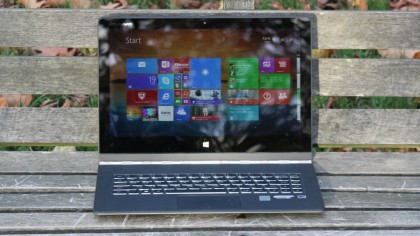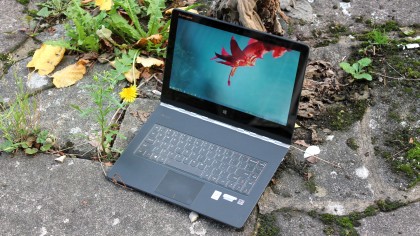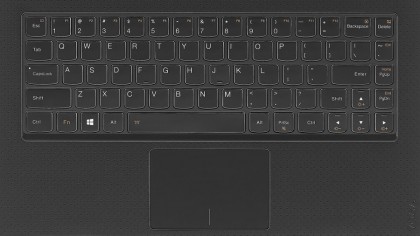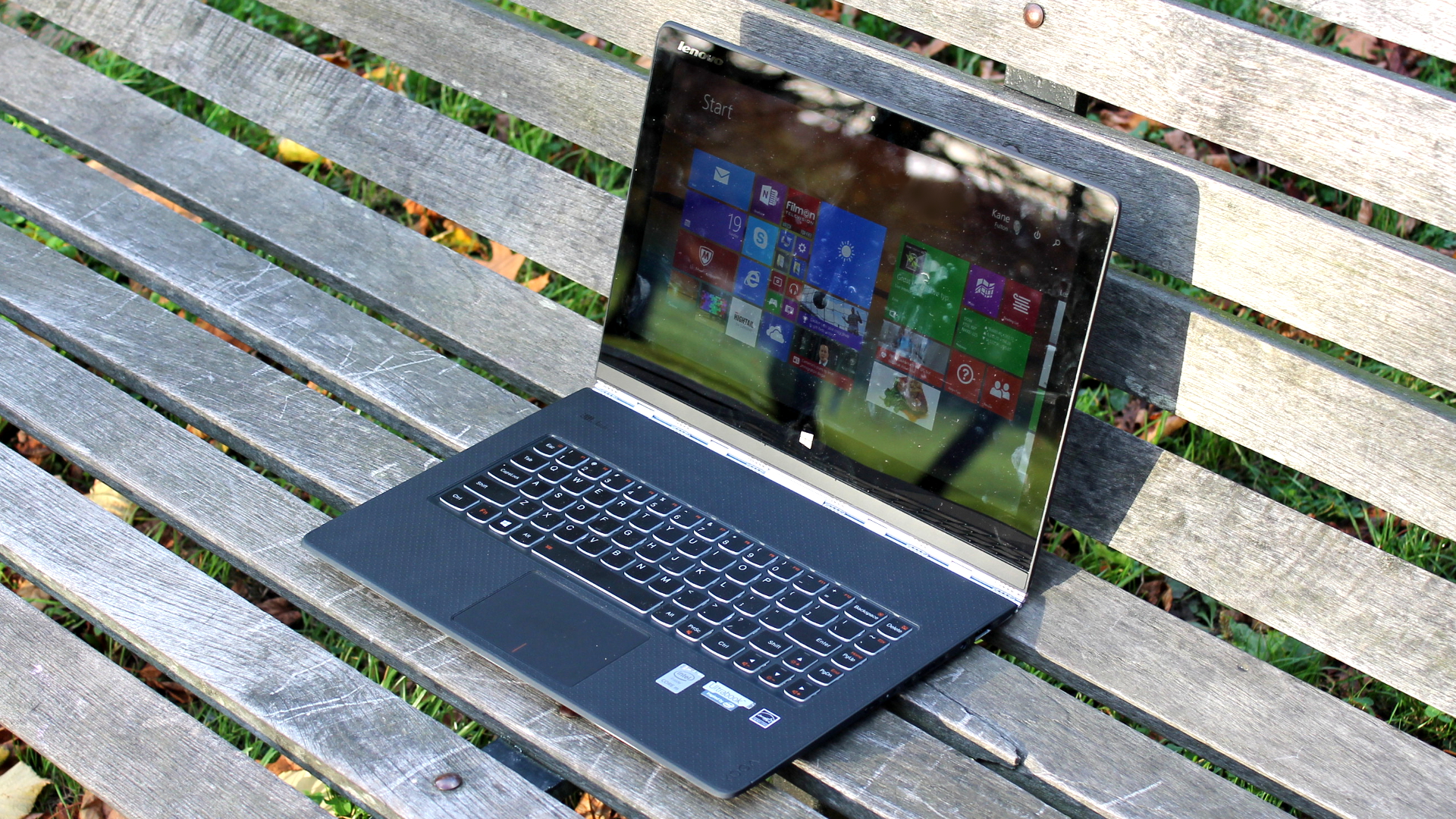Why you can trust TechRadar
Benchmarks
- Cinebench (Multi-Core): 13.3fps
- 3D Mark 11
- Ice Storm: 25,839
- Cloud Gate: 2,738
- Sky Diver: 1,406
- Fire Storm: 329
- PC Mark 8
- Home: 2,165
- Work: 2,704
- Battery life test
- Power saver: 5 hours 15 mins
- Balanced: 4 hours and 30 minutes
- High Performance: 2 hours and 57 minutes
- TechRadar Light Use battery test: 7 hours and 10 minutes
For the wad of cash you'll spend on the Yoga 3 Pro, it's not enough for it to look good - it has to perform too. It may be able to flex, but as powerlifters know, it's pointless doing so in the absence of muscle.
Under the hood is Intel's Core M-5Y70 CPU, which is clocked at 1.1GHz (turbo boost to 2.6GHz). As I've mentioned, it's based on Intel's Broadwell architecture, which brings the benefit of allowing manufacturers to make their Ultrabooks fanless (and thinner and quieter as a result). The Yoga 3 Pro isn't fanless, but it still runs very quiet. You'll occasionally hear its internal fan whirring away under heavier CPU or graphic-intense workloads.
Unfortunately, the move to Broadwell has had a negative impact on processing power compared to the Yoga 2 Pro. Last year's Ultrabook scored around 1,000 points more in PC Mark's Home and Work benchmarks. The Yoga 2 Pro's HD 4400 also scored slightly higher than the Yoga 3 Pro's HD 5300 in 3D Mark's more demanding Fire Strike and Cloud Gate benchmarks. However, the newer entrant performed better in the Ice Storm test, which simulates light gaming use to test the GPU.
The system runs cool most of the time. When it does begin to warm up under heavier loads, heat is concentrated to the top right-hand corner of the base, and I never found it to heat up to the point where it was uncomfortable.

Other specs include 8GB of RAM and a 256GB SSD from Samsung, which make for a nippy machine that boots up and shuts down almost instantaneously. Performance in Windows 8.1 apps is smooth, with the Yoga 3 Pro able to handle anything you can find in the Windows Store.
Graphics duties are taken care of by Intel's integrated HD 5300 solution, meaning only modest gaming is on the menu. Games running Valve's Source Engine (such as Team Fortress 2, or Half-Life 2) will manage a healthy 40 - 50 FPS on lower resolutions with details turned down. A more demanding title in Skyrim, on the other hand, only managed an average (and borderline unplayable) 30FPS on 1280 x 720.
Most tasks on the desktop can be undertaken without any sign of slowdown; 1080p videos play with a hitch (including when outputted to a larger monitor or TV), and medium-sized images in GIMP around 300MB in size can be scaled and resized with delays into tens of seconds, rather than minutes.
Battery strife
The Yoga 2 Pro's middling battery life was one of the main pain points of last year's outing, and poor performance has once again reared its head on the Yoga 3 Pro.
The move from Haswell to Broadwell was expected to increase efficiency, and while Lenovo states nine hours of continuous use, you won't hit that unless you use the machine very conservatively.
Our Light Use battery test: viewing websites, holding a couple of Skype calls, watching a few YouTube movies, editing documents and images (and so on) allowed the battery to run for just over seven hours. That was with Lenovo's battery power management panel set to 'Power Saver', brightness on 75%, keyboard back-lighting, Bluetooth and Wi-Fi all switched on.

For further analysis, I also ran PC Mark 8's punishing Home Battery Life test under all three of Lenovo's power management settings, with brightness set to 100% and Bluetooth and Wi-Fi switched on.
As expected, all three yielded lower results then the manual Light Use test, with particularly dismal results from the High Performance setting. Where the Yoga 2 Pro managed roughly 3 hours 10 minutes under the same conditions, the Yoga 3 Pro went for just 2 hours and 57 minutes.
This is not an Ultrabook that will go anywhere near all day if you want to use the display on full beam. Whether this is down to Lenovo's poor battery management software or Intel's Core M processor will become clear when more Ultrabooks based on Broadwell hit the market.
On the plus side, charging times aren't so bad. Set Lenovo's charging assistance software to Normal Mode and juice is restored up in around 2 hours 30 minutes. A second option, Conservation Mode, will top up from empty in around four hours but is less taxing on the battery level, which Lenovo reckons can help extend battery life if frequently used.
Keyboard and clickpad
I was impressed with the Yoga 2 Pro's keyboard, and the Yoga 3 Pro's is a more-than-solid offering with well-spaced chiclet keys that possess a decent amount of travel. It's here that the laptop's thin profile comes in as an advantage.
Because it sits so low, it almost feels like you're typing on the surface that it's resting on, allowing the wrists to rest at a comfortably low position. Its keys are once again shaped like those from Lenovo's Thinkpad line of devices, with a square top edge and rounded bottom.

Once caveat in this area is the lack of a F-row of keys, which is a curious and frustrating omission for an Ultrabook with a "Pro" moniker. There's plenty of room between the top of the keyboard and the hinges to squeeze one in, and the empty space winds up looking a little barren.
Even if a F-row wasn't included, pushing the keys higher up the keyboard would have allowed Lenovo to make the clickpad slightly larger. As things are, it's merely adequate, with a smooth texture that's a magnet for fingerprints.
I occasionally found that clickpad's sensitivity was a little on the low side and failed to register swipes if not enough pressure was applied. Clickpads, like keyboards, are subjective, and I prefer ones that are rock solid and highly sensitive (in terms of physical pressure required, not the cursor speed in Windows).
The MacBook Pro line has led the line in this area, and those on Fujitsu's Lifebook line of business Windows 8.1 notebooks tend to perform similarly well. As someone who has become accustomed to a MacBook Pro clickpad, I often became frustrated at the Yoga 3 Pro clickpad's imprecise nature.
Multimedia and apps
The Yoga 3 Pro's speakers are typical of most 13-inch laptops: loud enough to fill a small room, but sorely lacking in bass, so a dedicated external set will be required if you're planning on using it to provide the soundtrack at parties.
Out of the box, the speakers suffered from a crackling, distorted sound with the volume cranked up. This was fixed by going into Windows 8's Device Manager, uninstalling the Realtek audio driver and rebooting. That driver was replaced with a HD audio driver entry, and the crackling completely disappeared.
On the front of the Yoga 3 Pro's frame is a 720p webcam, which produces a video image clear enough for Skype calls and is comparable to a mid-range smartphone camera.
In terms of bundled Lenovo software, the company has given its adaptive "Harmony" software, which is designed to adapt to how you would use the machine over time, a short in the arm. Reading an e-book, for example, will see it automatically change the brightness and colour temperature according to environment lighting.
It can also apply a sepia-like on-screen filter to writing apps such as Evernote, which is designed to simulate a book's page. I found it more distracting than useful, though I don't doubt that it would reduce eye strain when used for hours at a time.
Current page: Performance and battery life
Prev Page Specifications and build quality Next Page Verdict
